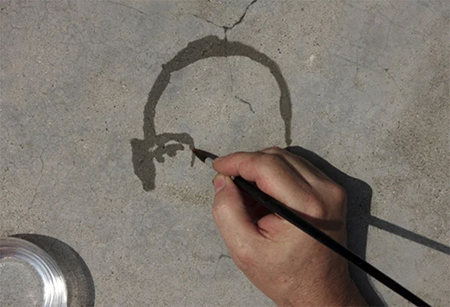
Continuing through January 16, 2022
Self-portraits repeatedly painted with water on sun-drenched cement fade away in Oscar Muñoz’s 2004 video, “Re/Trato (Portrait/I Try Again).” It’s the first piece encountered in this retrospective exhibition of work by the Columbian artist, whose practice spanning five decades centers around themes of memory, identity, history, knowledge and time. Like the exhibition, the video is a poignant reflection of the artist’s own way of being in the world and his creative process, in which concept, material, and form reflect the transience of existence, and the imperative to continue to create meaning even as it shifts amid internal and external forces.
Born in 1951, in a region beset by armed conflict, Muñoz creates works that explore both the specificity of his own geographic and temporal context and universal themes prevalent in multiple places and times. This traveling exhibition, co-organized by Phoenix Art Museum and the Blanton Museum of Art, features approximately 50 works, including installations, videos, drawings, sculptures and more. He works with diverse mediums, from charcoal pencil to coffee-tinctured sugar cubes, as well as more ephemeral materials such as water, fire, dust and light. Curated by Vanessa Davidson, the exhibition is organized around four themes: Presence/ Absence, Memory/Amnesia, Appearance/Disappearance, and Cohesion/Fragmentation. This body of work is particularly powerful when considered within the context of contemporary American culture, where historical revisionism, erasure of migrants and people of color, and systemic violence are at play.
The exhibition opened on September 11, twenty years after the terrorist attacks that killed nearly 3,000 people. Considering the ways 9/11 continues to alter individual and collective histories and memories adds powerful layers of meaning to Muñoz’s 1994-2008 floor installation titled “Ambulatório (Walking Place/Outpatient Ward).” Here, the artist encapsulated aerial photographs of the city Cali, a site of numerous bombings, in 36 contiguous tiles made with shattered security glass. Nearby, six serigraphs on steel disks mounted in a horizontal row look like blank mirrors until a viewer chooses to draw near and exhale, thus briefly manifesting the obituary portraits of people who’ve disappeared due to armed conflict or other abuses. Shown in the American Southwest, the 1995 work titled “Aliento (Breath)” speaks to genocide against Native peoples. It also calls to mind the final breaths of those lost to the pandemic and the murder of George Floyd amid his repeated cries of “I can’t breathe.”
The audio and video components of Muñoz’s work are especially impactful, in part because their quiet presence is a constant reminder of the ever-shifting nature of identity, relationships and social milieu. With “Sedimentaciones (Sedimentations),” a 2011 video projection that signals the centrality of photographic processes to Muñoz’s work, he delivers the sound of paper being moved through two trays of photographic chemicals as an arm rearranges assorted images with personal, mythological and art historical significance atop a table. In the 2006-2009 video titled “Hombre de arena (Sand Man),” human figures drawn in the sand appear to repeatedly climb upwards, only to be washed away by ocean waves that we can hear approaching the shore. As elsewhere, the artist conjures the myth of Sisyphus, harkening to the persistent struggle against death in the face of absurdity.
Several works incorporate text and imagery, often channeling intersections between language and power. For the 2015 video “Distopía (Dystopia),” Muñoz screenprinted text from George Orwell’s 1984 onto paper using charcoal dust, then placed the prints in water so the words would slowly fall away. Others, including the 2013-2016 marble sculpture “Doméstico (Domestic)” featuring eight empty picture frames set on a rounded shelf, have neither image nor text. Where some feel a void, others perceive a tabula rasa or blank slate.
His is a thoughtful, compelling creative process. But this survey also lends insight into the forces shaping contemporary American life, giving us pause to consider the ever-changing landscape of our own lives. The power of Muñoz’s work is to endlessly create new memories and meanings, both alone and in community.
